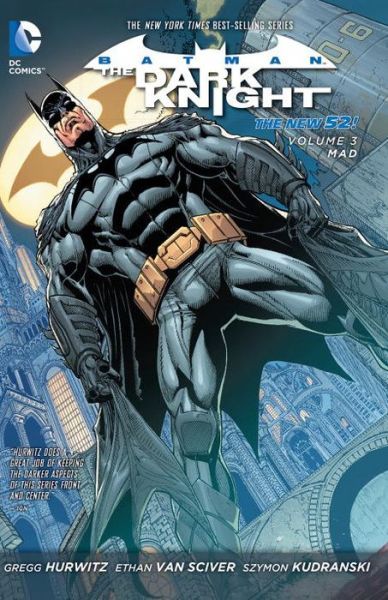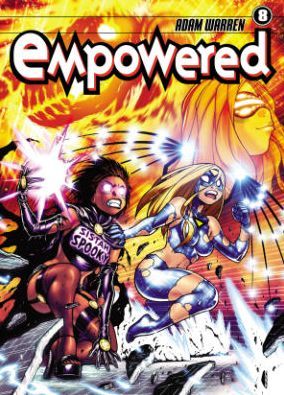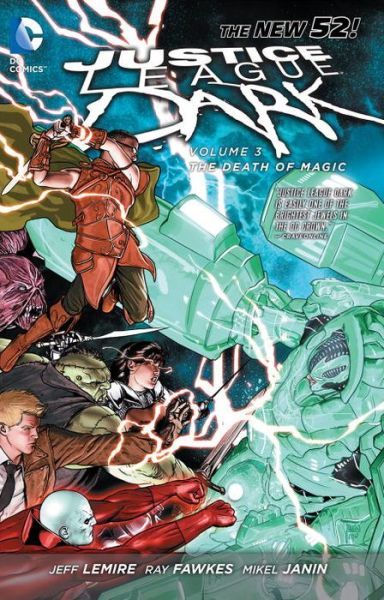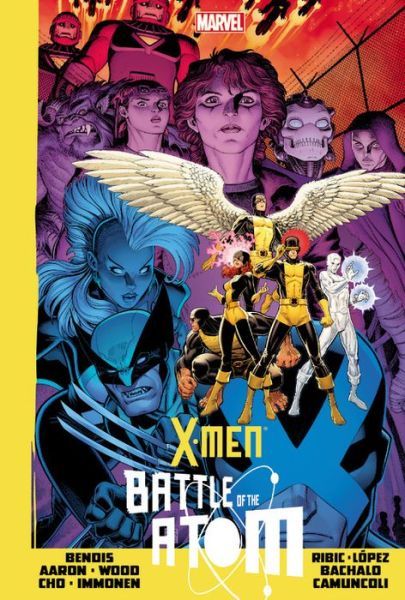Batman: The Dark Knight Vol. 3: Mad (DC Comics): Poor Batman. His new continuity is only a few years old, and already he's suffering from threat inflation, so that now seemingly every crime is one that could level Gotham City and every villain a mass-murderer with a three-figure body count to rival The Joker's.
In this volume -- collecting six issues and an annual from writer Gregg Hurwitz's run on The Dark Knight -- it's The Mad Hatter's turn for an upgrade. A villain formerly portrayed as either obsessed with hats or with Lewis Carrol's Alice books or both, depending on the writer, Jervis Tetch here begins his road to villainy by killing a rabbit, then uses a step-ladder to reach the face of an underling who he proceeds to murder by plunging his thumbs into the victim's eyes. From there, he murders a housewife by bashing her head in with an iron, he kills hundreds—hundreds!—of Gothamites through his mind-control technology, and he then has Batman's girlfriend killed...by having her beaten to death in front of him.
In response, Batman tears one of the Tweedles' jaws off, beats the diminutive Hatter until he's drenched in his villain's blood, then tosses him into a pond to drown until Alfred reminds him that he can't kill the Hatter, or else he'll be no different from him. I don't think Batman should ever resort to lethal force, but Alfred's argument isn't all that powerful as presented here, given that one side of the scale has a madman murdering scores of innocents, and the other has Batman killing said killer.
That's not the only surprisingly cliched bit of the story, which invents a new origin full of childhood trauma for Jervis Tetch akin to those Hurwitz previously gave The Scarecrow and The Penguin. Batman also decides he loves his current girlfriend, reluctantly reveals his secret identity to her and then, the very next night, one of his foes murders her while attempting to torture Batman's secret identity out of her.
It's a pretty problematic plot, to say the last.
Hurwitz does reinvent The Mad Hatter and make the character new and, good or bad, his own, and he writes some decent Alfred sarcasm. The book is made immensely readable by the contributions of artist Ethan Van Sciver, whose Batman has the grim visage of Brian Bolland's, and whose art is as hyper-detailed as Phil Jimenez's; his main innovation to drawing Batman is his huge, wing-shaped cape (His Mad Hatter is completely reinvented visually).
Unfortunately, the penultimate part of the story is drawn -- or "drawn" -- by Szymon Kudranski, whose dark, impenetrable, photo-referenced style makes several key passages downright illegible. I found myself staring at certain panels, waiting for my eyes to decipher them, like one of those magic sail boat poster thingees.
Serving as an epilogue of sorts is a fairly clever story in which Batman terrorizes The Penguin, Scarecrow and Mad Hatter on Halloween night, but being illustrated by Kudranski, many key moments are illegible, and at least one is laughably executed. On the fourth-to-last page, the villains lie in a heap at the bottom of a stair case. The prone Penguin levitates a few feet off the floor in front of it, while the Hatter hovers on his knees above the first few stairs. It's even lazier than it is ugly.
Empowered Vol. 8 (Dark Horse Comics): The main difference between the latest installment of Adam Warren's ongoing super-comic, one of the best superhero narratives currently in-progress, is the focus. This 200+ chunk of Emp's life features two long stories. The first is a series of vignettes foreshadowing the second; in it, Empowered and various supporting characters discuss their feelings and beliefs about the afterlife.
In the second, Empowered joins her magical-powered frenemy Sistah Spooky on a common superhero quest (The first iteration of which I encountered in Alan Moore's Swamp Thing, but that doesn't mean he necessarily invented its application to superheroes). That is, they journey to Hell in order to rescue fallen teammate (and Spooky's lover) Mindf@#k, whose soul has been condemned there.
It goes...well, it goes about as well as trips to Hell to rescue the souls of dead lovers usually do, now that I think of it. Devoid of Empowered's large, supporting cast, and probably the most serious—that is, light on the jokes—passage of the the series so far, it gives Warren the opportunity to really flex his design and storytelling muscles. His devil, his reveal of the surface of hell ("Oh, f@#k me. That's...that's not lava down there"), his depiction of a Spooky's suicidal battle with the massive, alien, creatures that protect the integrity of the place—it's all gorgeous and disturbing at once, made doubly so by Warren's stark black and white artwork.
Justice League Dark Vol. 3: The Death of Magic (DC): When it comes to creating the ongoing adventures of corporately-owned super-characters, what's the difference between recycling and remixing?
I couldn't get that question out of my mind while reading this book full of names familiar from many other comics I've read: John Constantine, Madame Xanadu, Zatanna, Deadman, The Books of Magic's Tim Hunter, The House of Mystery...even the story's location, a place called Epoch, shares its name with an old Justice League villain.
One obvious difference between the two is connotation, with recycling generally seen as a negative when discussing art, as it's the act of reusing what was previously discarded, while remixing generally involves taking pre-existing components, rearranging them in fresh, new ways, and creating something entirely different out of them.
I suppose it's worth noting that many of the characters in this collection of eight issues are ones that other comics creators in decades past have already remixed -- or recreated into their own versions -- before. So Alan Moore and Neil Gaiman might have been the writers who created Constantine and Hunter, for example, but this is Alan Moore's reinvention of Swamp Thing, and a Black Orchid Gaiman turned into a Vertigo character as well. The Frankenstein who appears is the one Grant Morrison and Doug Mahnke re-created from the Len Wein and Jim Aparo's early '70s Spawn of Frankenstein, itself a recreation of the literary character.
That may be why the book seemed like more an act of recycling than remixing. In the first of the two arcs included, Constantine's team journeys to a world where magic and science are at war, where Hunter is a key player (a plot that relies quite heavily on Si Spencer and Dean Ormston's Books of Magick: Life During Wartime series for inspiration, plus Phil Jimenez's Otherworld series, both of which were published by Vertigo in the mid '00s). In the second storyline, which guest-stars The Flash, the old JLA (and, briefly, Sandman) villain Doctor Destiny shows up for an issue or two, only to be killed off by story's end.
While there's so much that's so familiar, it amounts to little more than name-dropping, as these aren't the same versions of characters from the previous, better comics that introduced them, and their presence does little more than remind readers who know of them of those comics. And, for newer readers who don't, I can't imagine it amounts to much more than a parade of strange names and figures. Jeff Lemire writes all of these scripts, sometimes in collaboration with Ray Fawkes, while the art is produced by various combinations of Mikel Janin, Vicente Cifuentes, Graham Nolan and Victor Drujiniu.
Ultimately, I suppose whether one regards the contents of this particular book to be more recycling or remixing depends on how generous one is inclined to be. I didn't see a single thing I hadn't seen before, and couldn't find an example of Lemire trying to say anything with his stories other than "Here are some super-characters, doing things to fill pages."
X-Men: Battle of the Atom (Marvel Entertainment): This big, fat hardcover collects the ten-part, old-school crossover of four X-Men monthly titles, which was book-ended by X-Men: Battle of The Atom #1 and #2, and ran through two issues each of the Brian Michael Bendis-written primary books of the franchise (All-New X-Men and Uncanny X-Men), and the secondary titles (Wolverine and the X-Men and plain old X-Men, written by Jason Aaron and Brian Wood, respectively).
Just looking at the writers involved, that might seem like a lot of different creators with a lot of different voices, but the story is remarkably cohesive, and for the most part they all tell the same story from the same point-of-view in the same voice (The only real hiccups come in the Wood-written issues of X-Men, as members of the cast of his book who were completely absent in earlier chapters will sometimes suddenly appear, as if they were there all along).
The plot, like that of some of the best Marvel crossover events, is pretty simple, an epic extrapolation of the goings-on in the X-Men books (although if you're not reading at least the two Bendis books, I'm not sure this has much to offer you).
Cyclops and Wolverine are at odds, and each has their own team of X-Men and school for new, young mutants. Wolverine's team is the mainstream one, and includes Beast, Iceman, Storm, Kitty Pryde and most of the other X-Men, while Cyclops' includes Magneto, Emma Frost, Magik and their students. Beast had previously brought the original, teenage X-Men line-up (including the younger versions of himself, Cyclops and the others) to the present, in an attempt to shock Cyclops back to his old, non-revolutionary self.
Battle of The Atom features a set of X-Men from the future journeying to the present to convince the Purrent X-Men to send the Past X-Men back where they belong, or risk damaging the timestream irreparably and causing some great disaster. Past Jean Grey doesn't trust these Future X-Men, so she and Past Cyclops go on the run, calling to help from Present Cyclops' team. Later, another set of Future X-Men journey to the present, selling a different version of events. There is a lot of fighting, including battles where there are as many as four different versions of Iceman, three different versions of Beast and so on.
The title is pretty generic, and doesn't really have anything to do with the proceedings beyond as a vague reference to the X-Men as "children of the atom." X-Men: Battle Royale would have been more appropriate, given that it is essentially up to five different X-Men teams fighting one another in different combinations, to determine where to send the original team. Also, Sentinels and S.H.I.E.L.D. join the fight at the climax.
Aside from the unearned, status quo shake-up at the end, in which a character makes a decision that nothing in the book suggests she would make, it's quite tightly plotted and fairly exciting. I generally run between cold and lukewarm with the X-Men, but I really liked this one (And, in fact, have really been enjoying Bendis' X-books, much to my own surprise, as I also run somewhere between cold and lukewarm on his scripts these days). Too many artists are involved, but they're all good ones, and for the most part the book holds together visually almost as well as it does with the written component of the narrative.
I haven't been this excited about the X-Men since Grant Morrison burned them down and started rebuilding them at the turn of the millennium, and Battle of The Atom was like a huge, heaping helping of Bendis and company's X-Men: If the trade collections are meals, this was like a Thanksgiving feast.





